new posts in all blogs
Viewing: Blog Posts Tagged with: Wikipedia, Most Recent at Top [Help]
Results 1 - 25 of 36
How to use this Page
You are viewing the most recent posts tagged with the words: Wikipedia in the JacketFlap blog reader. What is a tag? Think of a tag as a keyword or category label. Tags can both help you find posts on JacketFlap.com as well as provide an easy way for you to "remember" and classify posts for later recall. Try adding a tag yourself by clicking "Add a tag" below a post's header. Scroll down through the list of Recent Posts in the left column and click on a post title that sounds interesting. You can view all posts from a specific blog by clicking the Blog name in the right column, or you can click a 'More Posts from this Blog' link in any individual post.

By: AlyssaB,
on 1/19/2016
Blog:
OUPblog
(
Login to Add to MyJacketFlap)
JacketFlap tags:
Books,
History,
Religion,
wikipedia,
Politics,
american history,
search engine,
google,
Barack Obama,
christianity,
President Obama,
Social Sciences,
*Featured,
american politics,
religious history,
religious belief,
Arts & Humanities,
information age,
Google search data,
Faith in the New Millennium,
The Future of Religion and American Politics,
religion and politics,
christian country,
Add a tag
On 7 January, 2016, I asked Google, “what religion is Barack Obama”? After considering the problem for .42 seconds, Google offered more than 34 million “results.” The most obvious answer was at the top, accentuated by a rectangular border, with the large word “Muslim.” Beneath that one word read the line, “Though Obama is a practicing Christian and he was chiefly raised by his mother and her Christian parents…” Thank you, Google.
The post What religion is Barack Obama? appeared first on OUPblog.
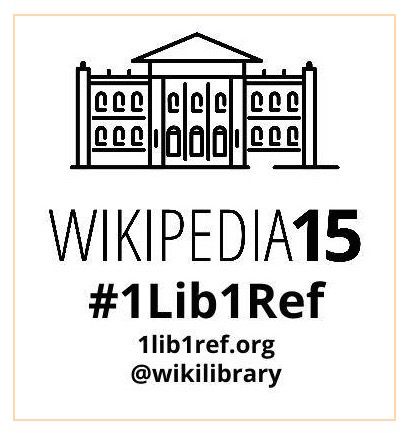
I am excited about the #1lib1ref project on Wikipedia. The goal is to get every librarian in the world (or a reasonable subsection) to add a citation to a Wikipedia article, just one. This helps make Wikipedia better in the process. I added my cite today to the Free Your Mind… and Your Ass Will Follow article. I’m not even trying to be sassy, that is just the page that was handed to me by this great tool that lets you know which articles need citations. I did some Googling, found a Google Book that had some supporting detail for the fact in question, used a book citation tool to turn it into Wikistyle and there you go. I might do two, just in case someone doesn’t have time to add a citation to Wikipedia this week. We have a facebook page and a lot of people using the #1lib1ref hashtag on Twitter. Join us!
Happy (early) Internet Day.
My husband and I are former drama majors, who met in community theater.
What does this have to do with the Internet? Patience, please!
We are huge movie fans. Pre-child, we would see three or four movies a week. Post-child and Pre-Netflix, we were Blockbusters' best customers. Watching movies is not a passive experience for us. We discuss the direction, the acting, the anachronisms that pop up. (The average upperclass American 1950's wife did NOT have pierced ears!)
For years our biggest argument was over a line in The Godfather. Did Tom Hagen say to Michael Corleone, "You know Pop worked hard to get you a deferment" or "You know Pop worked hard to get you into Furman"? (A small Baptist college in South Carolina...my husband is a South Carolinian.) It didn't matter that the book said Michael went to Dartmouth.
"They changed it for the movie," my husband insisted.
 |
| This guy went to Dartmouth. |
Enter the Internet! I first met "the 'Net" when I was a university reference librarian in the mid-90's. I learned that the right combo of search terms on the right search engine (my favorite was Alta Vista) would get me any information my heart desired.
The Godfather screenplay was online. Yes, Don Corleone got Michael a
deferment, not into
Furman.
Having settled the matter of Michael Corleone's alma mater, my husband and I continue to "discuss" movies and actors. Thanks to a wonderful database,
www.IMDb.com, our differences in opinion are settled before the first commercial.
"Oh there's what's-her-name. You know her; she was the Lucky Hat Girl in
Goodfellas?"
Tap tap tap. "Welker White. She does a lot of
Law and Order."
"Didn't we see
Goodfellas when we were dating?"
"Nope. We were living in Wisconsin."
Tap tap tap. "We're both wrong.
Goodfellas came out September 1990. We were living Alabama."

What does all this have to with writing? The Internet, used with caution, saves a boatload of research time. I wrote the first version of
Jimmy's Stars in 1984. I spent months in the microfilm room of the Pittsburgh Carnegie Library reading old newspapers, making hundreds of pages of notes. After I finished the book, I sensed it was missing something. (A plot! A conflict!) So,
Jimmy lived in my bottom desk drawer for nearly 30 years. (Never throw anything out. Especially something you have researched so long!) When I re-wrote the book (this time with a plot and conflict), I could re-verify my information from my home office with just a couple of hours of online searching.
In the past, I would begin a writing project by collecting information. Pictures, maps, books and bits of ephemera picked up here and there (ration books, streetcar schedules, old postcards.) My tiny office looked like an episode of
Hoarders. Now my pre-writing prep consists of a list of questions and items in an notebook. 99% of what I need, I can find and use online. The other 1% comes from my collection of diaries, family letters and photo albums. (OK, there is a still a corner of my office that looks like
Hoarders.)
Fairy tales can come true, if you are a reference librarian! No more juggling enormous reference books. No more waiting for the new edition of that reference book to come out. Instant reference gratification! Almost everything you could ever want to know is online, somewhere.
Along with the good stuff, comes the wrong, the bad and the half-truths (to say nothing about the wonderful world of Photoshopped pictures). It's the Wild Wild Cyberspace out there. Anyone can publish
anything online, and it doesn't have to be the truth. I am reminded of students from my first school library job, circa 1982. Do you remember the old Sprite commercials, that showed a "limon--half lemon, half lime"? I could not convince otherwise intelligent kids that a limon was not a real fruit because...
they saw it on TV!
 |
| A limon is a mythical fruit. |
Just because it's online, doesn't make it true.
 |
| There is no such thing as a jackalope, either! |
The Internet is an endless source of information
and misinformation. Some sites may or may not have accurate information (Wikipedia) that has to be verified another way. I found "satirical" news sites, such as
The Onion, masquerading as legitimate information sources. If it's too weird to be true, I either search the name of the original source (which will tell me if the site is "satirical" or affiliated with a particular political agenda) or I hit
www.snopes.com. Snopes keeps up with latest rumors, urban legends and conspiracy theories.
Some people avoid writing by playing Solitaire or Candy Crush online. Me? I can spend hours happily toggling from one site to another, answering for own curiosity (and not story research) question after question. And then double checking those answers.
As the old Russian proverb (which was swiped by President Reagan's speechwriter) says, "Trust but verify." If you don't verify on the front end, some editor is going to ask you to do it eventually.
Now, I am taking a break from blog writing to scroll through my new obsession,
www.murderpedia.org, a data base of murderers, living and dead, from around the world.
Don't ask, OK?
Happy Internet Day on the 29th, y'all
Posted by Mary Ann Rodman

By: Mark Myers,
on 6/12/2014
Blog:
(
Login to Add to MyJacketFlap)
JacketFlap tags:
religion,
wikipedia,
humor,
research,
Hair,
google,
Christian,
Christianity,
Dad,
knowledge,
daughters,
grooming,
It Made Me Laugh,
Add a tag
“I can only find three leg hairs” observed my youngest from the back seat. The chemotherapy killing her tumors also attacks any fast-moving cells – thus the hair loss, fingernail lines, and white blood cell reduction. She is twelve and had kind of fuzzy, blond legs a couple of months ago. Her smooth legs weren’t troubling to her, just something she noticed.
“Well, that would come in handy if you cared about that stuff yet,” I said, glad she didn’t.
“Why do girls shave their legs anyway?” she wondered. “I mean, who started that whole thing?”
A very interesting question. Who did start that? I assume Eve had leg hair when Adam popped the question. Do you think when they ate from the tree, not only did they figure out they were naked, but Adam also noticed her furry legs for the first time? Did he made a snide remark about Eve being only a slight step up from his former companion, the chimpanzee? Every guy knows the remorse of SCS – Stupid Comment Syndrome. The moment you say something to your wife and immediately wish you could turn back time to retract it. Adam’s comment sent Eve into a tizzy trying to scrape the hair off with a stick while stitching together the fig leaf bikini we see in all the pictures. If God created enmity between woman and serpent, imagine the enmity Adam created with his wisecrack.
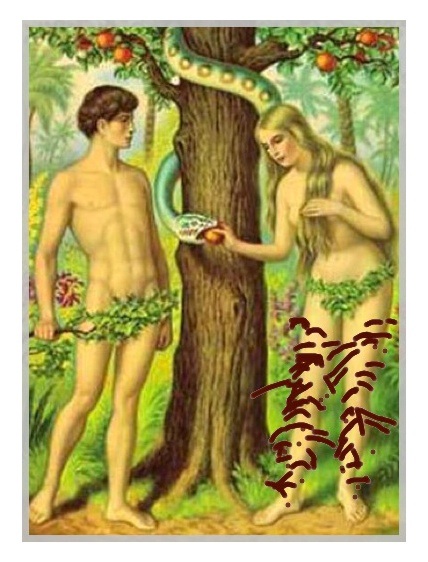
Ah, here is where I began a quest for knowledge. I had no interest in important knowledge, anyone can get that. The learning I sought is practically irrelevant outside of bar bets, board games, and trivia competitions. When did women first start shaving their legs?
Any thoughts?
Where do I turn? My best friends and cohorts in the immaterial: Google and Wikipedia, of course. Google brought me facts that I have to believe. It seems that women were so covered before the turn of the 20th century that it wasn’t necessary for them to shave – their body hair was kind of a honeymoon surprise. But as hemlines raised in the early 1900’s, razor sales increased. I can buy that.
The more compelling facts I found were about why women began shaving their underarm hair. They involve motion pictures, flappers, and old western women of ill repute. I would explain, but everyone likes a cliffhanger. My true audience is only twelve and wanted to know about leg hair anyway.
Besides, while on my search, I found a website called Mental Floss. It is like a Mythbusters of the inane. My evening was shot. I learned why bacon smells so good, 15 reasons we love Mr. Rogers, and why baby names have become increasingly female-sounding. Forget Wikipedia, some of that might actually be true. I have a new homepage!
After about three hours of copious research into absolutely nothing worthwhile, my daughter asked me why women started shaving their legs and I had to admit that I could tell her all why cows moo with accents, but had crammed so much useless knowledge into my finite brain, I had forgotten why women shaved their legs.
She left disappointed. Back to Wikipedia to start over…
But wait – an article titled, Do Racehorses Really Pee All That Much simply has to be read!
Filed under:
It Made Me Laugh 

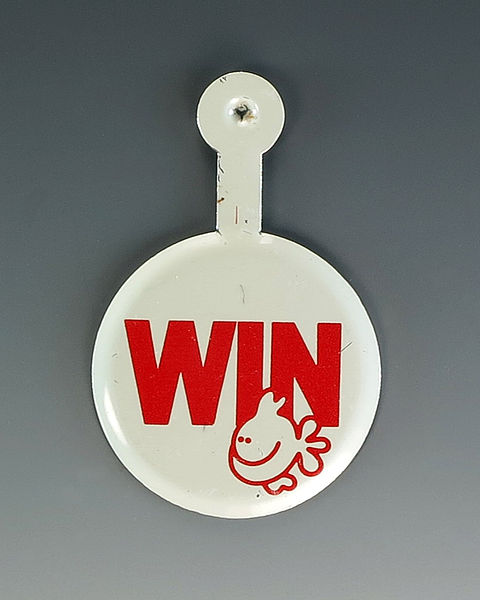
White campaign tab with “WIN” in bold, red letters accompanied by a small red fish.
I had read with interest the articles that came out recently about the Gerald R. Ford Presidential Library getting a Wikipedian in Residence. For more info, see this a short article about the library’s exhibits coordinator Bettina Cousineau talking about the library’s participation in the GLAM-Wiki Initiative (Galleries, Libraries, Archives, Museums with Wikipedia), and a little more about the Wikipedian in Residence program.
I think this program is nifty and I was excited this time because the WiR is a Master’s student at the University of Michigan’s iSchool. I dropped him a line and asked if he wouldn’t mind answering a few questions. Here is a small Q&A (done over email) with Michael Barera about his new internship.
JW: The Ann Arbor Journal says you’ve been a Wikipedian since 2001. Is that a typo or have you been an editor there for over ten years? In any case, what first brought you to Wikipedia or the Wikimedia school of websites? What is your favorite thing about working on Wikipedia?
MB: 2001 isn’t exactly the true year that I started on Wikipedia: I found the site first in 2005, and made my first edit in 2006. 2001 is the year of the oldest photograph that I have uploaded to Wikimedia Commons, so in a way my contributions go back to 2001, although I didn’t edit Wikipedia or Commons until 2006. I was actually introduced to Wikipedia by my high school Western Civilization teacher in 2005, which is interesting because most people don’t have such an academic entry into the site: perhaps he was part of the reason why I’ve always taken it seriously.
For the first year or so, before I made my first edit, I used Wikipedia essentially as an extension of my social studies textbook: I’ve always loved how much more inclusive it is than the mainstream social studies curriculum in this country. My favorite thing about working on Wikipedia is sharing everything I’ve created or contributed with everyone in the world. We all chip in a little, and because of the CC-BY-SA and GFDL licenses, everyone gets to share and enjoy in the totality, all without ads or paywalls or subscriptions. I love the fact that it really is “the free encyclopedia”, both in the “gratis” and “libre” senses of the word.
JW: You went to UMich for your undergrad work and now you’re pursuing your Masters at the School of Information. Is this internship a natural outgrowth of what you planned to do at the iSchool or is it more of a side hobby that turned into a big deal? What are your interest areas at the iSchool?
MB: The beautiful thing is that it is both part of my career plan at SI and an outgrowth of a multi-year hobby. That’s why it is so perfect for me, because it allows me to use both my U of M bachelor’s degree (which has a concentration in History) and my knowledge and experience with Wikipedia, all in one package. In terms of my areas of interest at SI, I am specializing in Archives and Records Management (and maybe dual-specializing in Preservation of Information as well), but I’ve really enjoyed everything I’ve taken so far, from human interaction in information retrieval to Python programming to dead media. SI really is a perfect fit for me!
JW: Sort of a silly question but are you literally “in residence” meaning that you get to go work at the library? Or is it more of a virtual residency?
MB: I’m literally “in residence” at the Library four hours per week, but as you know Wikipedia can’t be confined to just one place at a certain time, so there is plenty of spill-over above and beyond these four hours. It is rather interesting to have an internship that literally bleeds into my free time, but I love editing Wikipedia, so I can’t complain!
JW: This project seems like it’s sort of a trial partnership experiment for both Wikipedia and a US cultural institution. What are you hoping will come out of this partnership in addition to the stated goals of making more of the library’s public domain holdings available via Wikipedia?
MB: Well, to be fair, a number of US cultural institutions have already had Wikipedians in Residence: the National Archives and Records Administration, the Children’s Museum in Indianapolis, Consumer Reports, and the Smithsonian Institution have all beaten the Ford Presidential Library and Museum to the punch. For me, the biggest goals of my internship (in addition to the obvious desire to improve content on Wikipedia) are to foster and maintain a relationship between the Wikimedia movement and the Ford as well as to encourage content experts, like the people I work with at the Ford, to create Wikipedia accounts and to become Wikipedians themselves. I know it can be daunting at first, but there are lots of long-time users who are happy to give their help and guidance, myself included. We won’t bite the newcomers!
JW. Do you feel a little odd about being in a fishbowl with all of your Wikipedia edits and actions being visible or is this par for the course for you? What do you think is people’s largest misunderstanding about Wikipedia?
MB: Well, all of my Wikipedia edits and actions have always been visible (that’s the nature of the MediaWiki software), and while there is certainly an upsurge in media attention and awareness about the internship or me specifically, I don’t think that there has been a dramatic increase in the number of people paging through my edits or watching my talkpage. On Wikipedia, I still feel like a private citizen: I think most of the media attention has been at a very basic level, and I think some of it struggles to grasp the nuances of what I am doing or even the structure of Wikipedia itself, which brings me to your last question. In terms of people’s largest misunderstanding about Wikipedia, I think it is the simple fact that we are an encyclopedia: a tertiary source without original research. We are not a blog or a forum for anyone to post whatever he or she wants to post, but rather a dedicated and thoughtful group of “collectors” trying to assemble the world’s best encyclopedia piece by piece, bit by bit.
I think we sometimes get lumped in with other social media sites, like Facebook and Twitter, and while there are a few commonalities (like the fact each is made up of user-generated content), Wikipedia really is a lot more like Britannica than it is like a blog, at least in terms of the content itself and the work that goes on behind the scenes.
[these are follow-up questions from a few days after our initial exchange]
MB: I’ve always loved how much more inclusive it is than the mainstream social studies curriculum in this country.
JW: I’m with you there. Are there any particular examples that stand out to you?
MB: During my elementary, middle, and high school careers, I discovered that my history/social studies education was essentially a history of Western Europe and North America. While the curriculum has improved dramatically in terms of coverage of Native Americans, African Americans, and Asian Americans in the last few decades, there is very little Latin American, Eastern European, African, Asian, or Oceanian history taught at the primary or secondary levels in this country (and just about all of it directly impacts the United States, typically in negative ways, such as Vietnam’s one cameo appearance in American history during the Vietnam War). I think the heart of this issue is the old belief that history is “national myth-making” is still alive and well in this country, at least below the post-secondary level.
On the other hand, I absolutely loved how different history is at the college level: as an undergrad at the University of Michigan, it was refreshing to take history courses covering nearly every corner of the world that both attempted to show that country’s perspective and then critique it at the same time. My modern French history (1871-present) and Soviet/Russian history classes were the best examples, and I would highly recommend my professors, Joshua Cole and Ronald Grigor Suny, to anyone: they do it the right way, and I for one wish I had more exposure to that kind of “real history” when I was younger. Long story short, Wikipedia is much more like this post-secondary, “real history” than “national myth-making”, so I always enjoyed how much more objective Wikipedia is (although not perfectly objective, of course).
JW: One of the things that has been challenging for me in Wikipedia outreach is trying to convince people that they don’t need to get someone to do the editing, that they can be bold and dive in. Do you have any particular approach to trying to get people to get comfortable making their own edits?
MB: My advice for getting people to start contributing is simple. The next time our hypothetical potential editor is on Wikipedia, I would encourage him or her to create an account and then just stay logged in while reading articles. Anytime he or she spots a small error, such as a typo or punctuation issue, he or she should just go ahead and change it. Actually, an account isn’t even needed: readers can (on most articles) make such minor corrections without an account, too. Still, this notion of starting small is the real key, in my opinion: just start with the little things and become comfortable with the editing interface (and the notion of editing a wiki itself), and eventually that new editor will feel comfortable making larger and more substantial edits. That’s how it was for me many years ago.
JW: Are there other online reference sources (crowdsourced or not) online that are your “go to” sites when you are trying to do research either for Wikipedia or your other projects?
MB: The resources I use for referencing Wikipedia articles are broad and diverse, and they range widely from topic to topic, as is to be expected. One commonality, though, is that I use a lot of newspaper and journal articles: in most cases, they are reliable secondary sources that are very good at establishing the core facts that lie at the heart of the Wikipedia article. One hint for maintaining NPOV is to try to recognize the different sources and balance them with each other. For example, on the article on the 2001 Michigan vs. Michigan State football game, I made sure to use both the U of M and MSU athletic departments’ press releases and game notes.
And, in an even better example from my work on the article Queens of Noise (The Runaways’ sophomore album from 1977), I tried to effectively balance multiple perspectives on the content, including the recollections of Jackie Fox and direct quotes about specific songs and events from Joan Jett, Cherie Currie, and Kim Fowley. Most interestingly, that article includes two separate (and contradictory) accounts of why Jett sang lead vocals instead of Currie on one of the songs, one given by Fox and the other by Currie. The key is to make it clear who is saying what where, and so like the “real history” taught in colleges and universities across the nation (and the world), the article has become an effort to show the different perspectives in conversation with each other instead of just giving one point of view (as is the case with “national myth-making”).
JW: Cheers and thanks for doing this for me.
MB: My pleasure! Thanks for the interview, and take care!
What does Mark Carver have to say about Gothic Cathedrals and the Art of Melodrama?
As the seeds for The Age of Apollyon were taking root in my imagination, I read Victor Hugo’s The Hunchback of Notre Dame. In addition to being a fantastic story, that book opened my eyes to the breathtaking marvels of Gothic architecture. I’d always been a casual fan of cathedrals (who isn’t?) but after finishing Hugo’s masterpiece, I was determined to incorporate the Gothic church and all of its accompanying melodramatics into my own writing.

The Age of Apollyondoesn’t aim for the same heights as The Hunchback of Notre Dame. I never intended to write a massive, sweeping epic to ring throughout the ages – I just wanted to create a rip-roaring horror/action novel with all of the creepy, gothic-y goodness I could muster. So I chartered the Good Ship Google and set out on a virtual journey through dozens of cathedrals and churches, searching for the proper settings for my scenes. It was quite an endeavour, because I had to find several churches that fit descriptions I had already written. But with the power of Google Images and Wikipedia at my fingertips, I was able to find everything I was looking for.
A total of seven churches are featured in The Age of Apollyon. Not all of them fall under the umbrella of Gothic architecture, but they all contain rich history and dramatic atmosphere. Three of them, St. Peter’s Basilica at the Vatican, Notre Dame Cathedral in Paris, and the Milan Cathedral, are quite famous, while the others are less well-known. And, I must confess, not all of them emerge from the book unscathed. Yet each church plays an important role in the story, and though I’ve never visited them personally, I strove to capture what I imagined their unique personalities to be like. It was a tiring ordeal that devoured countless hours, but it was the most fun I’ve ever had doing research. Sometimes just staring (and drooling) over photos of these architectural masterworks was enough to inspire entire passages of writing.
My love affair with historic churches continues in the sequel to The Age of Apollyonentitled Black Sun, which I am currently writing at a feverish pace. These books aren’t only about churches and cathedrals of course, but for my money, it doesn’t get any better than a ferocious gun battle in a soaring candlelit sanctuary.
Or maybe I’ve just watched too many movies.
 Title: Wikiweb
Title: Wikiweb
Cost: $4.99
Platform: iPod, iPod Touch, iPhone, iPad – requires iOS 5 or later
It’s back to school time and this month the YALSA App of the Week bloggers are noting that and focusing each week on apps that are good for students and teachers. We’ll cover research, science, math, and staying organized. If you have a favorite school related app feel free to post information about it in the comments on our App of the Week posts. And, don’t forget, the American Association of School Librarians (AASL) is taking nominations for Best Apps for Teaching and Learning. You can make a nomination on the AASL website.
Anyone who still laments the loss of Google’s Wonder Wheel, or is looking for a tool to help teens to see connections between ideas will want to give Wikiweb a try.
There are two sides to the Wikiweb screen. The left side of the screen shows the map of a search and the connections between terms and ideas. On the right is where articles from Wikipedia (Wikiweb just searches Wikipedia) are displayed that relate to a specific search term or phrase. Check out the video from Wikiweb that provides a good overview of how the app works.
In some ways the power of Wikiweb is in the way that a researcher can build a diagram by tapping on various links in a Wikipedia article. For example, I started with a Hunger Games search. Instead of tapping on the hexagon that appeared on the left of the screen I built my own web by tapping on different links within The Hunger Games and related articles in Wikipedia. I tapped on Suzanne Collins in that article and then tapped on Nickelodeon, and then went back to Suzanne Collins and tapped on Katniss Everdeen. With each tap a hexagon was added to the map which showed the connections between the different people, organizations, and so on all related to The Hunger Games in some way. It’s a good way to see how and why connections exist.

Of course it is possible to have Wikiweb build a map for you and that’s accomplished by simply tapping on the hexagon for a particular term or phrase. It can be surprising to see what appears in those maps built by Wikiweb and it could work really well to have teens search a topic of interest, look at the connections Wikiweb shows on their map and talk about the value of those connections. Teens could then create their own map that shows the connections that they think are most valuable related to their topic of interest.
Maps can be shared via email and Twitter. If students are working on a project together they could build maps and share them with each other to show their ideas and what they think their team should focus on.
The app isn’t perfect. I wish that it was possible to have all labels appear. They come and go based on what’s on the screen. (Although when a map is shared all of the labels appear.) But, even with a few flaws, this is an app that can help teens think through their research and visualize ideas.
For more app recommendations visit the App of the Week Archive.












By:
Claudette Young,
on 7/5/2012
Blog:
Claudsy's Blog
(
Login to Add to MyJacketFlap)
JacketFlap tags:
Dune,
Uncategorized,
Art,
fiction,
Wikipedia,
Flash fiction,
Short story,
Friday,
Writing prompts,
Shai-Hulud,
Add a tag
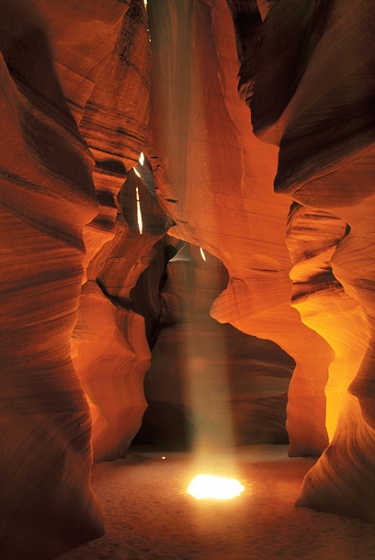
Flash Fiction Prompt
Each day a lovely little website referred to as Flashy Fiction offers a writing prompt to a photo. Today’s prompt was a two-fer because it’s been combined with Friday’s prompt.
I had to do one for today. The opportunity was too good and the prompt too right-up-my-alley. So, this is what I wrote for the photo above. I hope you enjoy it. And please, stop by to see all the offerings on Flashy Fiction. You’ll be glad you did.
The Light of Meaning
Within me grows a tension I cannot place. What could cause this sensation of impending destiny, which perches like a vulture just out of visual range? Does my breath come short and quick because of unexpected claustrophobia at the looks of this canyon before me?
My friends don’t seem to notice how silence surrounds this place, how the scent of dust carries with it a hint of the ancient. Their shouts fall short of my space, leaving me in a personal bell jar inside these striped red walls.
Illusions of undulating Dune’s Shai-Hulud flash across my mind. I wonder if this was how Paul felt the first time he waited for that beast to rise from the desert floor. Would there be such a ritual for me to perform for the coming secret to reveal itself? And how do I know there is a secret?
Footsteps echo. Shock sweeps through me. I recognize them as my own, though I don’t recall moving into the inner recesses of a side chamber. Dim illumination draws me forward, faster as hesitation drops away. I must know this thing that would be.
Twists and turns, dried water channels of exquisite sandstone, bring me, at last, to the chamber. I burst forth from the passage, panting in excitement and terror. Finally, I see what has haunted my vague dreams for longer than memory reaches. It waits; one glorious beam of pure light.
Within that circle of illumination is the future I’ve tried to escape from and now run to in a sprint of desperation. Could my heart beat any harder and remain caged within my body? Could my responding body contain so much light?
A jerk, like that of a tether drawn forward suddenly, pulls me into the beam of sunlight that squeezes through a tiny overhead opening. My head arches back. My chest swells and rises, as if I’m a mere marionette and someone has yanked my string upward. My mind is filled with music, sweet and gentle, as it ebbs and surges through the channels of my soul.
Home comes calling. I have been away longer than I can imagine right now. My mind registers the knowledge of a previous, though, different life elsewhere; a knowledge that explains so much that has confused me during this life.
The music and light fill me with the purpose I’ve been seeking. All is clear now. I have come this far to learn that only one act of mine is necessary for my life to have meaning for this world; to learn that with that act, I have completed my purpose here and can go home again.
Is there any better bliss than such sure knowledge?
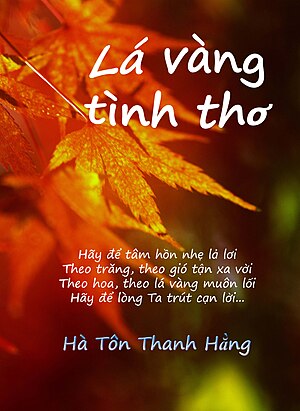
poem (Photo credit: Wikipedia)
I reached the finish line today of this year’s annual Poem-A-Day Challenge, hosted by Robert Lee Brewer of Writer’s Digest’s Poetic Asides.
Three days spent out in the wilds of the north country near the Canadian border has advantages. The wilds had a cook shack with great food, live entertainment, plenty of friendly folk to keep a body moving and interacting, learning and taking away new experiences and perspectives. It also had nighttime freezing temps, daily sunshine, sprinkles when relaxation was needed, and a small-town parade with all the usual trimmings.
While out there on the high plateau, I kept thinking about poetry and what I’d take away from the Rendezvous that I could use later for either verse or prose. I’d met unique people with otherwise long-lost talents, children who could defend themselves without anger or cook over an open fire without complaint. I’d seen crafts that rivaled any in a museum anywhere. And best of all, I came home knowing that I will go back next year for a repeat.
The PAD challenge continued without me, but I’ve managed to put together something for each of the days missed. I hope you enjoy these small offerings and that you’ll continue to return to this blog after this challenge ends. I have a new, improved blog for the end of the week, with new pages to visit and things to see. Until then, daily posts will continue.
Now, on to poetry.
Day 27 Prompt: “The Trouble is (blank)” Fill in blank, make it the title, and write poem.
The Trouble is Time Bending
Arbitrary limits,
On something non-existent,
Takes no talent, no finess.
Limiting nothing takes
More than care,
Requiring belief
That increments from
One mind equal
Production possibilities.
How can seconds become
Minutes or hours, when
Only days/nights exist in time?
Does breathing count
As a measuring stick, or pulse,
When clocks don’t function?
© Claudette J. Young 2012
Day 28 Prompt: Write a problem poem.
What Price Time
Forcing life into minutes and hours,
Taking life from the living,
Becoming machines, wound up
For the pleasure of someone else.
Can we not function except to
Sweep hands and crystal faces?
Are we mindless with this labyrinth,
Marking existence with clicks and clangs?
© Claudette J. Young 2012
Day 29 Prompt: Take a favorite line from an earlier poem this month, and rework it into a new poem.
Prayers Danced in Circles
Call forth with drum and song
Answers from Creator’s hand.
Step live
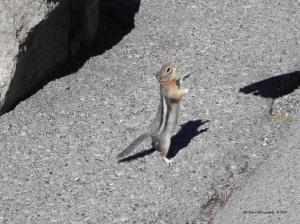 Today’s poem challenge is to write about an animal, addressing any aspect desired. Okay, I can do that. Like most people I’m fond of animals. They serve so many purposes within our lives that to have a world devoid of them seems sacrilegious.
Today’s poem challenge is to write about an animal, addressing any aspect desired. Okay, I can do that. Like most people I’m fond of animals. They serve so many purposes within our lives that to have a world devoid of them seems sacrilegious.
Growing up in the country guaranteed that I knew and appreciated the roles of animals in our daily lives. So many years later, I still consider them the gifts of the earth, put on loan to us; teachers to teach us how to be guardians. You can decide for yourselves if we’ve ever learned the lessons.
Some creatures inhabit our dwellings as friends and family members. Others enrich our lives with their colors, textures, uniqueness, and myriad dimensions. The poems I’ve done today for this challenge are from both sides of the animal question; in house and outside it.
As always, I hope you enjoy these small efforts of mine. Take the time to comment; share some of your animal tales with others, if you wish. Above all, take a good look at what your life would be like without the non-human inhabitants in your life.
Companion Truth
Brandy orbs trusting, I see
Filled with love looking at me,
Gentle power of loyalty
Ever near, ever dear sentry.
Raise the call with nose held high
Licker of feet for miles gone by,
Pass this way my care to enjoy
Walk at heel my life an envoy.
© Claudette J. Young 2012
Vixen’s Siren
Screams fill the night,
Terrorizing the listener.
Finger hovers over 911,
Until reason asserts truth.
It’s spring;
Her annual mating ritual begins
With blood-chilling siren song,
Seeking company for the nonce,
The vixen readies to entertain.
© Claudette Young 2012
Related articles



 2 Comments on PAD Day 26—Fur, Fowl and Animal Poems, last added: 4/29/2012
2 Comments on PAD Day 26—Fur, Fowl and Animal Poems, last added: 4/29/2012












 Title:
Title: 














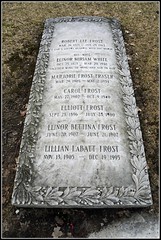

 Say what you will about Wikipedia—that it’s unreliable, that it’s unaccountable, that it’s run by a bunch of idealistic zealots—the fact remains that it is one of the most heavily accessed web resources in the world.
Say what you will about Wikipedia—that it’s unreliable, that it’s unaccountable, that it’s run by a bunch of idealistic zealots—the fact remains that it is one of the most heavily accessed web resources in the world.

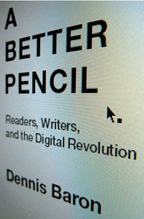 University of Illinois. His book,
University of Illinois. His book, 





 ibrarian?
ibrarian?



 took a stab at writing a Wikipedia stub on one of my favorite Second Life locations,
took a stab at writing a Wikipedia stub on one of my favorite Second Life locations, 
I tried a couple of these. In one I didn’t add a citation; instead I just removed some vapid unproven PR-speak; in the other I dug up some film history in a book, clarified some language, and cited the addition.
Thank you!
[…] appreciated this post from Jessamyn West promoting the #1Lib1Ref campaign (One Librarian, One Reference), which seeks to […]